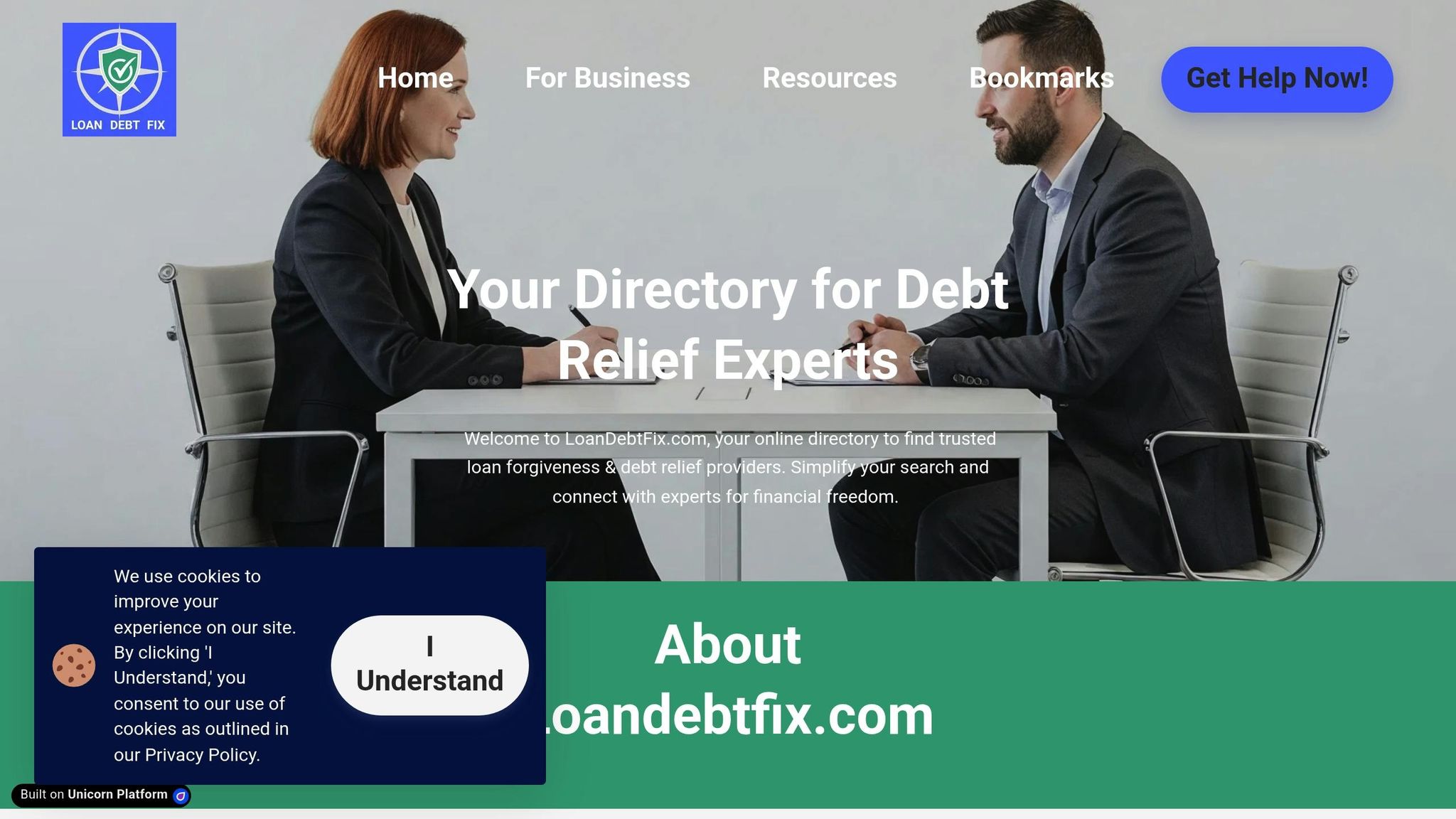Defaulting on student loans can severely impact your finances, credit, and future opportunities. Here's what you need to know:
- Delinquency vs. Default: Missing a payment makes your loan delinquent, but it becomes a default after 270 days (federal loans) or 120 days (private loans).
- Consequences: Default leads to wage garnishment, tax refund seizure, and credit damage lasting up to seven years. Federal loans lose benefits like forbearance and deferment.
- Solutions for Federal Loans:
- Rehabilitation: Make 9 on-time payments to remove the default from your credit report.
- Consolidation: Combine loans into a new one for quicker resolution but keep the default mark as "resolved."
- Solutions for Private Loans:
- Settlement: Pay a reduced lump sum but face credit damage and possible tax implications.
- Refinancing: Lower payments if you have good credit but lose federal loan benefits if applicable.
Act quickly to avoid long-term issues. Resources like studentaid.gov or professional advice can guide you toward the best resolution.
How to Get Student Loans Out of Default Fast
What Happens When You Default
Defaulting on student loans comes with serious consequences that can ripple through your financial life. Once your loan enters default, many of the protections borrowers rely on are lost.
Financial Consequences
Defaulting on a student loan can lead to lenders accelerating your debt, meaning the entire balance - principal, interest, and fees - becomes due immediately. For federal loans, this also means losing access to deferment, forbearance, and eligibility for future federal aid. On top of that, you may face collection fees that add to your overall debt. Private loans often include similar acceleration clauses, although the specifics depend on the lender.
Credit Score Damage
Defaulting doesn’t just hurt your wallet - it can leave a lasting mark on your credit. A default can stay on your credit report for up to seven years, dragging down your credit score. This makes it harder to secure new loans or qualify for lower interest rates. The impact can spill over into other areas of life, like renting an apartment or landing a job, especially if a credit check is part of the hiring process.
Legal Actions and Government Collection
Federal loans in default give the government the power to garnish your wages without needing a court order. They can also seize your tax refunds to recover the debt. In some states, defaulting on federal student loans could even jeopardize your professional license, which might affect your career.
For private loans, lenders usually need to go through the courts to garnish wages or claim assets. However, they can still take legal action to recover what’s owed.
These collection efforts, along with added fees, can continue until the loan is either fully repaid or brought back into good standing through rehabilitation or consolidation. The longer the default lasts, the harder it becomes to regain financial stability.
How to Fix Default Status
Federal Loan Options
If you’ve defaulted on a federal loan, there’s a way to get back on track. You can consolidate the defaulted loan into a new Direct Consolidation Loan, which will remove the default status and stop any collection actions. To do this, you’ll need to either start repaying the new loan under an Income-Driven Repayment (IDR) plan or make three consecutive on-time payments on the defaulted loan. With federal collections resuming on May 5, 2025, it’s important to act quickly to resolve the default and avoid further complications.
sbb-itb-3a8c5bf
Comparing Your Options
Once you've looked into how to resolve default status, it’s time to weigh your options for regaining financial stability. Defaulted student loans require thoughtful decision-making, as federal and private loans come with their own sets of pros and cons.
Federal Loans: Rehabilitation vs. Consolidation
When it comes to federal loans, you have two primary options: rehabilitation and consolidation. Both can help you get out of default, but they work differently and offer unique benefits:
| Factor | Loan Rehabilitation | Direct Consolidation |
|---|---|---|
| Eligibility | Available once per loan | No limit on usage |
| Time to Complete | 9–10 consecutive on-time payments | Immediate upon approval |
| Credit Report Impact | Default notation removed completely | Default remains but shows as paid |
| Federal Benefits | Fully restored | Federal benefits resume immediately |
| Payment Flexibility | Must make 9 payments before benefits return | Benefits restored immediately |
| Cost | No fees | No fees |
Rehabilitation takes longer but completely removes the default from your credit report, offering a cleaner financial slate. On the other hand, consolidation is faster and gives you instant access to federal benefits, though the default mark will remain on your credit history as "resolved." If you need immediate relief and access to federal aid, consolidation is the way to go. If a long-term clean credit record is your priority, rehabilitation might be the better choice.
Private Loans: Settlement vs. Refinancing
Unlike federal loans, private loans require a different approach. The two main options for resolving defaulted private loans are settlement and refinancing.
| Factor | Debt Settlement | Refinancing |
|---|---|---|
| Best For | Borrowers in severe financial distress | Borrowers with improved credit and stable income |
| Typical Cost | 40%–70% of loan balance as a lump sum | Typically features favorable terms |
| Credit Impact | Significant negative impact initially | Can improve credit with on-time payments |
| Tax Consequences | Forgiven debt counts as taxable income | No tax implications |
| Long-term Outcome | Debt resolved but credit damaged | Potentially lower payments and better terms |
| Eligibility | Must be in or near default | Requires good credit and stable income |
Settlement is a viable option if you're in deep financial trouble, but it comes with drawbacks like taxable forgiven debt and a major hit to your credit score. Refinancing, on the other hand, is ideal for borrowers with better credit and a steady income. It can lower your monthly payments and improve loan terms, though it may extend the repayment period and increase the total cost over time.
Important Note: Refinancing federal loans into private loans means giving up federal benefits like income-driven repayment plans, forbearance, and forgiveness programs. Carefully review the terms before deciding. While a lower monthly payment might sound appealing, a longer repayment period could mean paying more in the long run.
Taking the time to evaluate these options thoroughly is a key step toward restoring your financial health and stability.
Getting Professional Help
Dealing with student loan default can feel overwhelming, but you don’t have to tackle it alone. While it's possible to handle many aspects of default resolution yourself, seeking professional help can make the process smoother and less stressful. Here’s where you can turn for expert advice and resources.
LoanDebtFix.com Directory

LoanDebtFix.com is an online platform that connects borrowers with experienced debt relief professionals across the United States. Whether you need help with student loan rehabilitation, debt consolidation, credit counseling, or even bankruptcy guidance, this directory makes finding the right expert simple. You can search by location or type of service, and each listing includes essential details like credentials, service areas, and contact information, so you know exactly who you’re reaching out to.
Free Resources and Guides
In addition to its directory, LoanDebtFix.com offers a blog packed with practical guides and articles to help you understand your options. These resources break down complex topics into easy-to-follow explanations, covering everything from loan forgiveness programs to tax implications and application processes. For instance, the guide "Understanding How Loan Forgiveness Works" provides a thorough overview of eligibility criteria and procedural steps.
Using these tools alongside professional advice can help you make more informed decisions. By equipping yourself with knowledge, you’ll be better prepared to discuss your situation with experts and move closer to resolving your student loan default effectively.
Next Steps
Now that you’ve got a handle on the concept of default, it’s time to take action. Here’s how you can start addressing the situation effectively:
Turn to official resources first.
If you have federal loans, head over to studentaid.gov to review your options. Programs like Fresh Start can help you get back on track [12,14]. If your loans are already with the Department's Default Resolution Group, visit myeddebt.ed.gov for targeted support.
Access free help.
The Institute of Student Loan Advisors (TISLA) provides free guidance for both federal and private loans. Whether you’re exploring loan forgiveness, repayment plans, or ways to resolve a default, TISLA offers email support Monday through Friday.
Look into broader financial counseling.
If default is just one piece of a larger financial puzzle, consider reaching out to the National Foundation for Credit Counseling (NFCC). They offer personalized advice to help you manage your overall financial situation. One client, LeAnne, shared her experience:
"We realized that we had more expenses than income. My counselor helped me prioritize my expenses and informed me of options to handle my debt."
Seek professional expertise.
For more complex cases, the CSLA Institute directory connects borrowers with Certified Student Loan Professionals (CSLP®). These specialists can provide tailored advice to help you resolve your default. Additionally, platforms like LoanDebtFix.com allow you to search for trusted debt relief professionals based on your location or specific needs.
Taking that first step - whether it’s loan rehabilitation, consolidation, or another solution - can prevent long-term financial harm. Acting now not only helps restore your credit but also sets you on the path to a more secure financial future.
FAQs
What’s the difference between loan rehabilitation and consolidation for federal student loans, and how do they affect my credit score?
When dealing with federal student loan default, you have two main options: loan rehabilitation and loan consolidation. While both can help, they work differently and affect your credit score in distinct ways.
Loan rehabilitation involves making nine on-time payments within ten months. The big advantage? Once you complete this process, the default status is removed from your credit report, which can give your credit score a noticeable boost. Additionally, rehabilitation restores access to perks like deferment and income-driven repayment plans.
Loan consolidation, on the other hand, combines your defaulted loans into a single new loan. It’s a quicker process - usually done in about 30 to 45 days - but there’s a catch: the default record stays on your credit report. While consolidation helps you get out of default faster and simplifies repayment, the lingering default can still impact your credit history.
If improving your credit score is your primary goal, rehabilitation is often the better route. But if you’re looking for a faster way to resolve the default and move forward, consolidation might be the better fit.
Should I choose settlement or refinancing to resolve my defaulted private student loans?
Deciding whether to go with a settlement or refinancing for your defaulted private student loans largely depends on your financial circumstances and what you hope to achieve. A settlement means negotiating to pay less than the full amount you owe. While this can help you resolve the debt faster, it can also hurt your credit score. Refinancing, on the other hand, might lower your interest rate and monthly payments, but it typically requires a solid credit score and steady income. Plus, if your loan is already in default, refinancing might not even be an option.
If your main goal is to resolve the debt quickly and refinancing isn’t possible due to poor credit or the loan's default status, settlement could be the way to go. However, if you qualify for refinancing and are focused on reducing long-term costs, it might be the better route. Take a close look at your credit, income, and overall financial goals before deciding which option makes the most sense for you.
What should I do right away if I default on my student loan to reduce financial and legal risks?
If you've fallen behind on your student loan payments and entered default, it's important to act quickly to minimize the consequences. Start by reaching out to your loan servicer to explore options such as loan rehabilitation, loan consolidation, or an income-driven repayment plan. These programs can help you regain access to federal aid and put a stop to actions like wage garnishment or tax refund offsets.
Taking prompt action can prevent further harm to your credit score and avoid additional financial setbacks. Options like rehabilitation or consolidation can even remove the default status from your record, giving you a fresh start in managing your loans more effectively.



